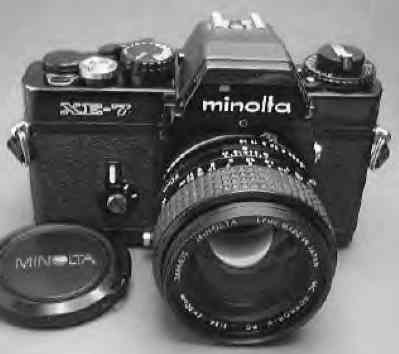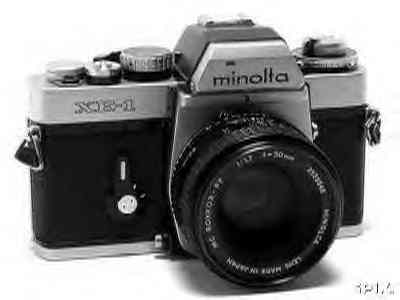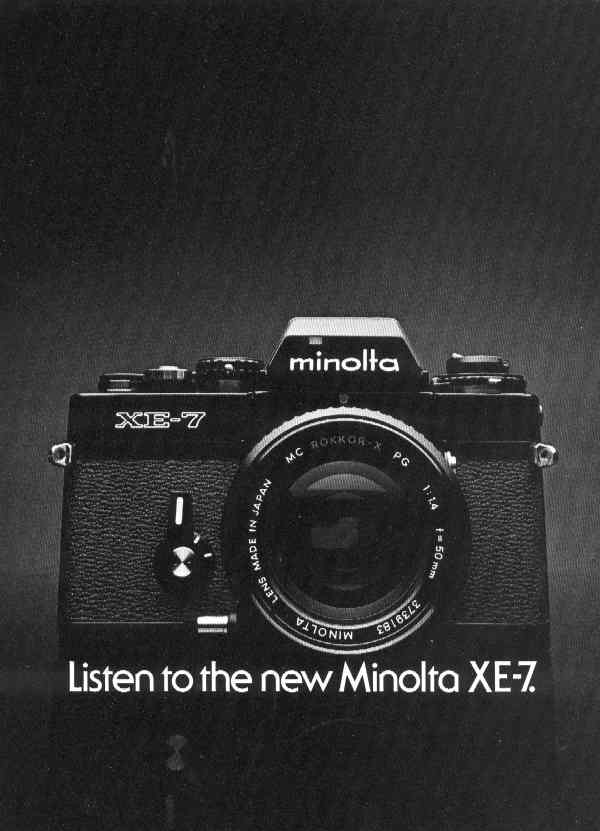

XE-7
(1974) The XK was a fabulous camera, but it was designed for the professional market. While it was full-featured, it was expensive. So how do you get the automatic features of the XK into a regular-priced, consumer camera? Other companies had already done it, like the Canon EF, the Pentax ES and the Nikkormat EL -- all from 1972. Minolta found itself in a game of "catch up". Minolta talked to Leica and Copal and together they designed a completely new camera! Think of the XE-7 as an XK without the interchangeable heads and screens -- although there were some other differences as well. For example, the XE-7 had a completely new, Leitz-Copal, quiet, vertical shutter with speeds of 4 - 1/1,000 (in automatic exposure mode), and 1 - 1/1,000 plus B (in manual exposure mode). This new shutter also offered a faster flash synch speed - 1/90. The XE-7 has aperture-preferred automatic exposure, metered-manual and manual modes of exposure. Just set the f-stop and the camera picked an appropriate shutter speed.
The XE-7 was a superb camera and more like the SRT series than any other automatic-exposure camera that Minolta would ever make. It's large and heavy -- like an SRT -- and has a viewfinder readout that an SRT user can love. It has the same focusing screen as the SRT102, and shows the manually selected f-stop on the top. The big change is that the manually selected shutter speed no longer appears as a line-up across the bottom of the screen. The manual speed still appears in the viewfinder, but it's now in a window on the top of the screen. On the right, instead of the match-needle set-up of the SRT series, the XE-7 has a new shutter speed scale -- with a twist. In manual mode, the single needle points to the recommended shutter speed.

In automatic-exposure mode, the manually-set shutter speed is replaced with a "A" in the viewfinder and the single needle points to the shutter speed that the camera will automatically select. And just like with the XK, the XE-7 will select intermediate shutter speeds in auto mode. If the scene calls for 1/97, that's what you'll get -- not the nearest compromise. So with the XE-7, just like with the SRT102, the eye never needs to be removed from the viewfinder in order to compose and expose the scene. Think of the XE-7 as an SRT102 with auto-exposure capability.
Many feel, justifiably so, that the XE-7 has the best possible viewfinder. Not only does it include a split-image rangefinder and microprism collar, but it has sensible, complete exposure information. In manual mode, the viewfinder quickly shows the set f-stop and shutter speed, as well as the speed recommended by the meter. It's very easy to use by just matching the actual speed with the recommended speed. And in auto-exposure mode, it shows the manually-selected f-stop and the shutter speed that will be automatically set by the camera. On most of Minolta's later cameras, the manually-set, shutter speed window was removed. Because of this, with these later cameras, it can be hard to know if the shutter speed scale is indicating the manually-set speed, or the recommended speed, or the automatically set speed.
The XE-7 also boasted the easiest multiple exposure capability of any Minolta SLR, a DOF/stop-down button, an adjustable self-timer, a +/-2 exposure compensation dial, a hot shoe, a viewfinder shutter to keep out stray light, and a film advance window The list of features goes on with a battery check, a film memo holder and locks on all the crucial settings. For a comparative look at the major features of the XE-7 models, check out MINMAN's SLR table -- the world's most complete!
Unfortunately, just like the XK, since the shutter in the XE-7 is electronic, it is dependent on the battery, and if the battery dies, you are in trouble. But the XE-7 has some features to help you along as your batteries die. Not only does it have an easy to use battery check, if you forget to use it and the battery gets too weak, the XE-7 will lock-up the mirror rather than give you incorrect exposures. And in the event that you didn't bring a spare, you can switch to the B or X (1/90) setting, which are mechanical speeds, and contiue to take picutres. Sure, you'll have to guesstimate the exposure since the meter won't work, but you can still walk home with exposed film if you remember the f-16 rule.
There were actually three versions of the XE-7, depending on where you bought
the camera.


With all of the features of the XE-7, it's no wo wonder there are so many who say that the XE-7 is the best 35mm camera EVER made, by anyone! But, at the time, the XE-7 was expensive, so Minolta opted to produce a less-expensive version the next year -- the XE-5. The XE-7 was manufactured from 1974 to 1977, and was destined to have a short run. Other companies were producing smaller, lighter automatic-exposure cameras, such as the Olympus OM-2 and the Pentax ME. Minolta knew it had to keep up with the times -- and it did -- by producing the XD-11. But the XE-7 lived on by becoming the basic ingredient of the Leica R3.

RETURN TO THE MANUAL
MINOLTA HOME PAGE We didin't want to do this, but since other websites
have been stealing our stuff, we have no alternative but to state:
COPYRIGHT@1995-2023 by
Joe McGloin.
All Rights Reserved. The material on this website is protected by US Federal
copyright laws. It cannot be copied or used in any manner without specific
approval from the owner.
The material on this website is protected by US Federal copyright laws. It cannot be copied or used in any manner without specific approval from the owner.